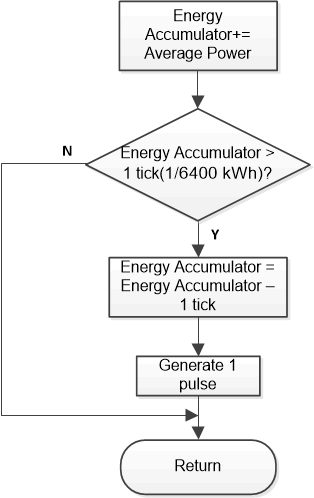TIDUEM7A April 2019 – February 2021
- Description
- Resources
- Features
- Applications
- 5
- 1System Description
-
2System Overview
- 2.1 Block Diagram
- 2.2 Highlighted Products
- 2.3 Design Considerations
- 2.4
Hardware, Software, Testing Requirements, and Test Results
- 2.4.1 Required Hardware and Software
- 2.4.2
Testing and Results
- 2.4.2.1 Test Setup
- 2.4.2.2 Test Results
- 3Design Files
- 4Related Documentation
- 5About the Author
- 6Revision History
2.3.2.3.3.2 LED Pulse Generation
In electricity meters, the energy consumption of the load is normally measured in a fraction of kilowatt-hour (kWh) pulses. This information can be used to accurately calibrate any meter for accuracy measurement. Typically, the measuring element (the MSP432 MCU) is responsible for generating pulses proportional to the energy consumed. To serve both these tasks efficiently, the pulse generation must be accurate with relatively little jitter. Although time jitters are not an indication of bad accuracy, time jitters give a negative indication of the overall accuracy of the meter. The jitter must be averaged out due to this negative indication of accuracy.
This application uses average power to generate these energy pulses. The average power accumulates at every DRDY port ISR interrupt, thereby spreading the accumulated energy from the previous one-second time frame evenly for each interrupt in the current one-second time frame. This accumulation process is equivalent to converting power to energy. When the accumulated energy crosses a threshold, a pulse is generated. The amount of energy above this threshold is kept and a new energy value is added on top of the threshold in the next interrupt cycle. Because the average power tends to be a stable value, this way of generating energy pulses is very steady and free of jitter.
The threshold determines the energy "tick" specified by meter manufacturers and is a constant. The tick is usually defined in pulses-per-kWh or just in kWh. One pulse must be generated for every energy tick. For example, in this application, the number of pulses generated per kWh is set to 6400 for active and reactive energies. The energy tick in this case is 1 kWh / 6400. Energy pulses are generated and available on a header and also through light-emitting diodes (LEDs) on the board. GPIO pins are used to produce the pulses.
In the reference design, the LED that is labeled "Act" corresponds to the active energy consumption for the two-phase sum. "React" corresponds to the cumulative two-phase reactive energy sum.
Figure 2-21 shows the flow diagram for pulse generation.
 Figure 2-21 Pulse Generation for Energy Indication
Figure 2-21 Pulse Generation for Energy IndicationThe average power is in units of 0.001 W and a 1-kWh threshold is defined as: